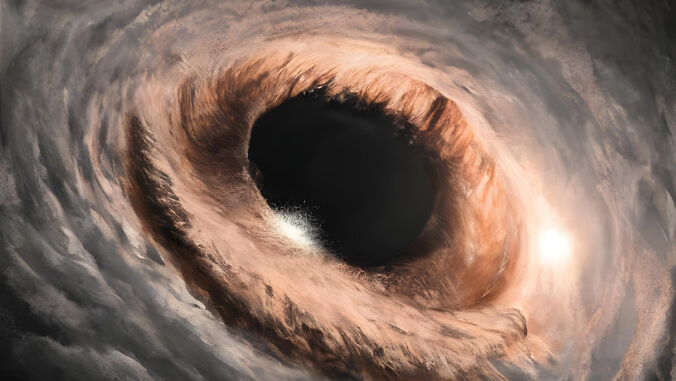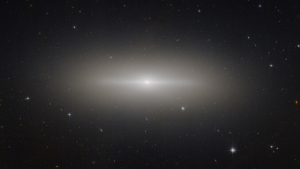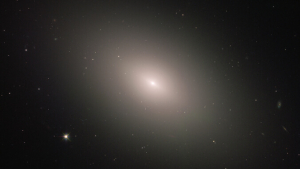1st Observational Evidence Linking Black Holes To Dark Energy
Searching through existing data spanning 9 billion years, a team of researchers led by scientists at University of Hawaiʻi at Mānoa has uncovered the first evidence of “cosmological coupling”—a newly predicted phenomenon in Einstein’s theory of gravity, possible only when black holes are placed inside an evolving universe.
 Artist’s impression of a supermassive black hole. Cosmological coupling allows black holes to grow in mass without consuming gas or stars. UH Mānoa astrophysicists Duncan Farrah, a faculty member at the Institute for Astronomy and the Department of Physics and Astronomy, and Kevin Croker, a professor of physics and astronomy led this ambitious study, combining Hawaiʻi‘s expertise in galaxy evolution and gravity theory with the observation and analysis experience of researchers across nine countries to provide the first insight into what might exist inside real black holes.
Artist’s impression of a supermassive black hole. Cosmological coupling allows black holes to grow in mass without consuming gas or stars. UH Mānoa astrophysicists Duncan Farrah, a faculty member at the Institute for Astronomy and the Department of Physics and Astronomy, and Kevin Croker, a professor of physics and astronomy led this ambitious study, combining Hawaiʻi‘s expertise in galaxy evolution and gravity theory with the observation and analysis experience of researchers across nine countries to provide the first insight into what might exist inside real black holes.
“When LIGO heard the first pair of black holes merge in late 2015, everything changed,” said Croker. “The signal was in excellent agreement with predictions on paper, but extending those predictions to millions, or billions of years? Matching that model of black holes to our expanding universe? It wasn’t at all clear how to do that.”
 Caldwell 53 (NGC 3115) is most notable for the supermassive black hole that can be found at its center (Image credit: NASA, ESA, and J. Erwin, University of Alabama)
Caldwell 53 (NGC 3115) is most notable for the supermassive black hole that can be found at its center (Image credit: NASA, ESA, and J. Erwin, University of Alabama)
The team has recently published two papers, one in The Astrophysical Journal and the other in The Astrophysical Journal Letters, that studied supermassive black holes at the hearts of ancient and dormant galaxies.
The first paper found that these black holes gain mass over billions of years in a way that can’t easily be explained by standard galaxy and black hole processes, such as mergers or accretion of gas.
The second paper finds that the growth in mass of these black holes matches predictions for black holes that not only cosmologically couple, but also enclose vacuum energy—material that results from squeezing matter as much as possible without breaking Einstein’s equations, thus avoiding a singularity.
With singularities absent, the paper then shows that the combined vacuum energy of black holes produced in the deaths of the universe’s first stars agrees with the measured quantity of dark energy in our universe.
 Researchers studied galaxies such as Messier 59 to determine if the mass of their central black holes changed throughout the past 9 billion years (Image credit: ESA/Hubble & NASA, P. Cote)
Researchers studied galaxies such as Messier 59 to determine if the mass of their central black holes changed throughout the past 9 billion years (Image credit: ESA/Hubble & NASA, P. Cote)
“We’re really saying two things at once: that there’s evidence the typical black hole solutions don’t work for you on a long, long timescale, and we have the first proposed astrophysical source for dark energy,” said Farrah, lead author of both papers.
“What that means, though, is not that other people haven’t proposed sources for dark energy, but this is the first observational paper where we’re not adding anything new to the universe as a source for dark energy: black holes in Einstein’s theory of gravity are the dark energy.”
These new measurements, if supported by further evidence, will redefine our understanding of what a black hole is.
This model at present should be considered as an exciting hypothesis, one which can be experimentally tested with more studies of existing data. Fortunately there is and will be more information which can be used to validate or reject the theory, though this will likely take some years. If confirmed it represents a major change in cosmology and points toward a revolution in our understanding of the universe.
Publication: Duncan Farrah, et al. Observational Evidence for Cosmological Coupling of Black Holes and its Implications for an Astrophysical Source of Dark Energy. The Astrophysical Journal Letters, (2023). DOI: 10.3847/2041-8213/acb704
Original Story Source: University of Hawaii at Manoa

 Alerts Sign-up
Alerts Sign-up